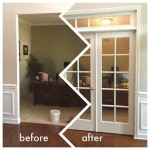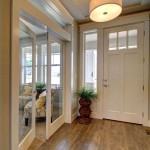How Much Does It Cost To Install a Prehung Interior Door?
Installing a prehung interior door is a common home improvement project that can enhance the aesthetic appeal and functionality of a living space. Prehung doors, which come already mounted in a frame, simplify the installation process compared to installing a door slab alone. While this simplifies the process, understanding the costs associated with the project is crucial for budgeting and decision-making. This article provides a comprehensive overview of the factors influencing the cost of installing a prehung interior door, covering material costs, labor expenses, potential additional costs, and regional variations.
The cost of installing a prehung interior door is not a fixed number and varies depending on several factors. These factors can be broadly categorized into material costs, labor costs, and other potential expenses that might arise during the installation process. By understanding these components, homeowners can accurately estimate the likely cost of their door installation project.
Material Costs: The Door and Its Components
The primary material cost is, of course, the prehung door itself. The price of a prehung interior door can vary significantly based on the door's material, style, and size. Common materials include hollow-core, solid-core, wood, and composite options. Each material type offers different advantages in terms of cost, durability, sound insulation, and aesthetic appeal.
Hollow-core doors are generally the most affordable option. These doors consist of a lightweight core, often made of cardboard or a honeycomb structure, faced with a thin veneer. While they are inexpensive and easy to handle, hollow-core doors offer minimal sound insulation and are not as durable as other options. The cost of a hollow-core prehung door typically ranges from $50 to $150.
Solid-core doors offer a significant improvement in terms of durability and sound insulation. These doors have a solid core, often made of wood fibers or composite materials, providing a more substantial feel and better performance. Solid-core doors are more expensive than hollow-core doors, with prices ranging from $150 to $400 or more, depending on the material and finish.
Solid wood doors represent the higher end of the price spectrum. These doors are made entirely of wood, such as pine, oak, or maple, and offer superior durability, aesthetic appeal, and sound insulation. Solid wood doors are also more resistant to warping and damage compared to other options. However, they are also the most expensive, with prices potentially exceeding $400 and ranging upwards depending on the wood type and detailing.
Composite doors are an alternative that blends the benefits of different materials. These doors often feature a wood frame with composite panels, offering a balance of durability, affordability, and aesthetic flexibility. Composite doors can range in price from $100 to $300, depending on the specific materials and construction.
Beyond the door itself, other material costs include hardware, such as doorknobs, hinges, and strike plates. The cost of hardware can vary depending on the style, finish, and quality. Basic hardware sets can be purchased for as little as $15 to $30, while more decorative or high-end hardware can cost $50 or more per door. Additionally, materials like shims, nails, screws, and paint or stain for finishing touches will contribute to the overall material costs. These supplementary materials typically add another $20 to $50 to the total expense.
Labor Costs: Hiring a Professional Installer
The cost of labor is a significant factor in determining the overall expense of installing a prehung interior door. Hiring a professional installer ensures that the door is properly installed, level, and functioning correctly. Labor costs can vary depending on the installer's experience, the complexity of the installation, and the geographical location.
On average, the labor cost to install a prehung interior door ranges from $75 to $300 per door. This figure can vary based on the following considerations:
Experience and Skill Level: Experienced carpenters or contractors typically charge higher rates than less experienced handymen. However, their expertise can ensure a higher quality installation and minimize the risk of errors.
Complexity of the Installation: The complexity of the installation can significantly impact labor costs. If the existing door frame is damaged or requires modifications, the installation process will be more time-consuming and expensive. Similarly, if the door requires custom fitting or if there are unusual structural issues, the labor costs will increase.
Geographical Location: Labor costs vary significantly depending on the geographical location. In metropolitan areas with a higher cost of living, labor rates tend to be higher than in rural areas. The demand for skilled labor can also influence pricing.
Homeowners should obtain multiple quotes from different installers to compare prices and services. It is important to ask for a detailed breakdown of the labor costs, including the hourly rate and the estimated time required for the installation. Checking references and reviews can provide insights into the installer's reputation and quality of work.
While DIY installation is an alternative, homeowners need to consider their skill level and the potential risks involved. Improper installation can lead to functional issues, such as doors that don't close properly or are not level. It can also result in structural damage to the door frame or the surrounding walls. The cost of repairing these issues can often exceed the cost of hiring a professional installer in the first place.
Potential Additional Costs: Addressing Unexpected Issues
In addition to the material and labor costs, homeowners should be prepared for potential additional expenses that might arise during the installation process. Unexpected issues can occur, particularly in older homes, that require additional work and materials, thereby increasing the overall cost of the project.
Framing Issues: One common issue is an out-of-square or damaged door frame. If the existing frame is not perfectly square, the installer may need to make adjustments to ensure that the new prehung door fits properly. This may involve shimming the frame, adding reinforcement, or even rebuilding parts of the frame. These repairs can add $50 to $200 or more to the overall cost, depending on the extent of the damage.
Door Size Modifications: Standard door sizes are readily available, but if replacing a door in an older house, the opening might not be standard. Modifying the door opening to fit the prehung door can add to the cost. This process involves adjusting the framing to create a correctly sized opening, which takes time and skill. This modification can range anywhere from $100 to $500 depending on the extent of the work.
Drywall Repairs: During the installation process, it is possible to damage the surrounding drywall. This can occur when removing the old door frame or when making adjustments to the opening. Repairing drywall can involve patching holes, sanding, and painting, which can add $30 to $100 or more to the cost of the project.
Disposal Fees: The removal and disposal of the old door and frame can also incur additional costs. Some installers include disposal fees in their overall estimate, while others charge separately. Disposal fees can range from $20 to $50, depending on the local regulations and the size of the door.
Painting and Finishing: While some prehung doors come pre-finished, others require painting or staining. The cost of painting or staining the door can vary depending on the type of finish, the number of coats required, and whether the homeowner chooses to do it themselves or hire a professional. Painting or staining can add $50 to $200 or more to the overall cost.
Electrical Work: In some cases, installing a prehung door may require modifications to electrical wiring. This is particularly common if the door is near a light switch or outlet. Hiring an electrician to relocate or rewire electrical components can add $100 to $300 or more to the cost of the project.
Homeowners should discuss potential contingency plans with the installer and set aside a budget for unforeseen expenses. Having a financial cushion can help mitigate the impact of unexpected issues and ensure that the project stays on track.
In summary, the cost to install a prehung interior door is a multifaceted issue involving the price of the prehung door itself, labor costs and unexpected issues that may arise. Careful planning and research, along with obtaining multiple quotes, are essential for budgetary considerations. Understanding these factors allows homeowners to approach their door installation project with confidence.

How Much Does It Cost To Install Doors The Home Depot

Door Installation Cost Guide Interior Exterior Mr Handyman

How To Install A Prehung Door Making Maanita

How To Install A Prehung Door Tips From Novice Addicted 2 Decorating

Installing A Prehung Interior Door Jamb Switch Rogue Engineer

Pre Hung Doors Interior Door Replacement Company

How To Replace An Interior Door Prehung Replacement Diy Family Handyman

How To Install A Prehung Door Tips From Novice Addicted 2 Decorating

Installing A Prehung Interior Door Jamb Switch Rogue Engineer

Costs Of Interior Exterior Door Installation Allbetter
Related Posts








